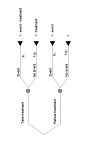Method for evaluating prediction models that apply the results of randomized trials to individual patients
- PMID: 17550609
- PMCID: PMC1914366
- DOI: 10.1186/1745-6215-8-14
Method for evaluating prediction models that apply the results of randomized trials to individual patients
Abstract
Introduction: The clinical significance of a treatment effect demonstrated in a randomized trial is typically assessed by reference to differences in event rates at the group level. An alternative is to make individualized predictions for each patient based on a prediction model. This approach is growing in popularity, particularly for cancer. Despite its intuitive advantages, it remains plausible that some prediction models may do more harm than good. Here we present a novel method for determining whether predictions from a model should be used to apply the results of a randomized trial to individual patients, as opposed to using group level results.
Methods: We propose applying the prediction model to a data set from a randomized trial and examining the results of patients for whom the treatment arm recommended by a prediction model is congruent with allocation. These results are compared with the strategy of treating all patients through use of a net benefit function that incorporates both the number of patients treated and the outcome. We examined models developed using data sets regarding adjuvant chemotherapy for colorectal cancer and Dutasteride for benign prostatic hypertrophy.
Results: For adjuvant chemotherapy, we found that patients who would opt for chemotherapy even for small risk reductions, and, conversely, those who would require a very large risk reduction, would on average be harmed by using a prediction model; those with intermediate preferences would on average benefit by allowing such information to help their decision making. Use of prediction could, at worst, lead to the equivalent of an additional death or recurrence per 143 patients; at best it could lead to the equivalent of a reduction in the number of treatments of 25% without an increase in event rates. In the Dutasteride case, where the average benefit of treatment is more modest, there is a small benefit of prediction modelling, equivalent to a reduction of one event for every 100 patients given an individualized prediction.
Conclusion: The size of the benefit associated with appropriate clinical implementation of a good prediction model is sufficient to warrant development of further models. However, care is advised in the implementation of prediction modelling, especially for patients who would opt for treatment even if it was of relatively little benefit.
Similar articles
-
The future of Cochrane Neonatal.Early Hum Dev. 2020 Nov;150:105191. doi: 10.1016/j.earlhumdev.2020.105191. Epub 2020 Sep 12. Early Hum Dev. 2020. PMID: 33036834
-
The implications of competing risks and direct treatment disutility in cardiovascular disease and osteoporotic fracture: risk prediction and cost effectiveness analysis.Health Soc Care Deliv Res. 2024 Feb;12(4):1-275. doi: 10.3310/KLTR7714. Health Soc Care Deliv Res. 2024. PMID: 38420962
-
Safety and Efficacy of Imatinib for Hospitalized Adults with COVID-19: A structured summary of a study protocol for a randomised controlled trial.Trials. 2020 Oct 28;21(1):897. doi: 10.1186/s13063-020-04819-9. Trials. 2020. PMID: 33115543 Free PMC article.
-
Adjuvant chemotherapy in early breast cancer.Dan Med J. 2016 May;63(5):B5222. Dan Med J. 2016. PMID: 27127018 Review.
-
Patterns of failure following surgical resection for malignant pleural mesothelioma.Thorac Surg Clin. 2004 Nov;14(4):567-73. doi: 10.1016/j.thorsurg.2004.06.006. Thorac Surg Clin. 2004. PMID: 15559064 Review.
Cited by
-
Prognostic Role of Dynamic Changes in Serological Markers in Metastatic Hormone Naïve Prostate Cancer.Cancers (Basel). 2023 Sep 2;15(17):4392. doi: 10.3390/cancers15174392. Cancers (Basel). 2023. PMID: 37686668 Free PMC article.
-
A framework for evaluating markers used to select patient treatment.Med Decis Making. 2014 Feb;34(2):159-67. doi: 10.1177/0272989X13493147. Epub 2013 Jun 27. Med Decis Making. 2014. PMID: 23811760 Free PMC article.
-
Estimating treatment effects for individual patients based on the results of randomised clinical trials.BMJ. 2011 Oct 3;343:d5888. doi: 10.1136/bmj.d5888. BMJ. 2011. PMID: 21968126 Free PMC article. Clinical Trial.
-
Aspirin for primary prevention of vascular events in women: individualized prediction of treatment effects.Eur Heart J. 2011 Dec;32(23):2962-9. doi: 10.1093/eurheartj/ehr423. Epub 2011 Nov 16. Eur Heart J. 2011. PMID: 22090661 Free PMC article. Clinical Trial.
-
Characterizing expected benefits of biomarkers in treatment selection.Biostatistics. 2015 Apr;16(2):383-99. doi: 10.1093/biostatistics/kxu039. Epub 2014 Sep 3. Biostatistics. 2015. PMID: 25190512 Free PMC article.
References
-
- Gill S, Loprinzi CL, Sargent DJ, Thome SD, Alberts SR, Haller DG, Benedetti J, Francini G, Shepherd LE, Francois SJ, Labianca R, Chen W, Cha SS, Heldebrant MP, Goldberg RM. Pooled analysis of fluorouracil-based adjuvant therapy for stage II and III colon cancer: who benefits and by how much? J Clin Oncol. 2004;22:1797–1806. doi: 10.1200/JCO.2004.09.059. - DOI - PubMed
-
- Loprinzi CL, Thome SD. Understanding the utility of adjuvant systemic therapy for primary breast cancer. J Clin Oncol. 2001;19:972–979. - PubMed
-
- Kent DM, Hayward RA, Griffith JL, Vijan S, Beshansky JR, Califf RM, Selker HP. An independently derived and validated predictive model for selecting patients with myocardial infarction who are likely to benefit from tissue plasminogen activator compared with streptokinase. Am J Med. 2002;113:104–111. doi: 10.1016/S0002-9343(02)01160-9. - DOI - PubMed
-
- 2006. http://www.mskcc.org/nomograms Accessed July 20.
LinkOut - more resources
Full Text Sources
Other Literature Sources


